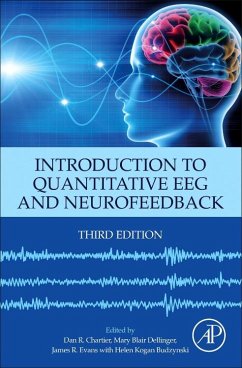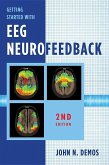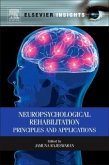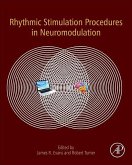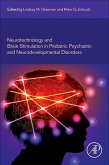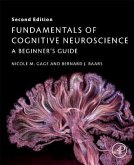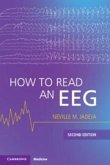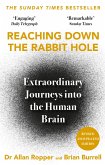Introduction to Quantitative EEG and Neurofeedback
Herausgeber: Chartier, Dan R.; Dellinger, Mary Blair; Evans, James R.; Budzynski, Helen Kogan
Introduction to Quantitative EEG and Neurofeedback
Herausgeber: Chartier, Dan R.; Dellinger, Mary Blair; Evans, James R.; Budzynski, Helen Kogan
- Gebundenes Buch
- Merkliste
- Auf die Merkliste
- Bewerten Bewerten
- Teilen
- Produkt teilen
- Produkterinnerung
- Produkterinnerung
Introduction to Quantitative EEG and Neurofeedback, Third Edition offers a window into brain physiology and function via computer and statistical analyses, suggesting innovative approaches to the improvement of attention, anxiety, mood and behavior. Resources for understanding what QEEG and neurofeedback are, how they are used, and to what disorders and patients they can be applied are scarce, hence this volume serves as an ideal tool for clinical researchers and practicing clinicians. Sections cover advancements (including Microcurrent Electrical Stimulation, photobiomodulation), new…mehr
Andere Kunden interessierten sich auch für
![Getting Started with Eeg Neurofeedback Getting Started with Eeg Neurofeedback]() John N. DemosGetting Started with Eeg Neurofeedback50,99 €
John N. DemosGetting Started with Eeg Neurofeedback50,99 €![Neuropsychological Rehabilitation: Principles and Applications Neuropsychological Rehabilitation: Principles and Applications]() Neuropsychological Rehabilitation: Principles and Applications47,99 €
Neuropsychological Rehabilitation: Principles and Applications47,99 €![Rhythmic Stimulation Procedures in Neuromodulation Rhythmic Stimulation Procedures in Neuromodulation]() Rhythmic Stimulation Procedures in Neuromodulation77,99 €
Rhythmic Stimulation Procedures in Neuromodulation77,99 €![Neurotechnology and Brain Stimulation in Pediatric Psychiatric and Neurodevelopmental Disorders Neurotechnology and Brain Stimulation in Pediatric Psychiatric and Neurodevelopmental Disorders]() Neurotechnology and Brain Stimulation in Pediatric Psychiatric and Neurodevelopmental Disorders101,99 €
Neurotechnology and Brain Stimulation in Pediatric Psychiatric and Neurodevelopmental Disorders101,99 €![Fundamentals of Cognitive Neuroscience Fundamentals of Cognitive Neuroscience]() Nicole M. GageFundamentals of Cognitive Neuroscience54,99 €
Nicole M. GageFundamentals of Cognitive Neuroscience54,99 €![How to Read an Eeg How to Read an Eeg]() Neville M. Jadeja (UMass Chan Medical School)How to Read an Eeg55,99 €
Neville M. Jadeja (UMass Chan Medical School)How to Read an Eeg55,99 €![Reaching Down the Rabbit Hole Reaching Down the Rabbit Hole]() Dr Allan RopperReaching Down the Rabbit Hole9,99 €
Dr Allan RopperReaching Down the Rabbit Hole9,99 €-
-
-
Introduction to Quantitative EEG and Neurofeedback, Third Edition offers a window into brain physiology and function via computer and statistical analyses, suggesting innovative approaches to the improvement of attention, anxiety, mood and behavior. Resources for understanding what QEEG and neurofeedback are, how they are used, and to what disorders and patients they can be applied are scarce, hence this volume serves as an ideal tool for clinical researchers and practicing clinicians. Sections cover advancements (including Microcurrent Electrical Stimulation, photobiomodulation), new applications (e.g. Asperger's, music therapy, LORETA, etc.), and combinations of prior approaches. New chapters on smart-phone technologies and mindfulness highlight their clinical relevance. Written by top scholars in the field, this book offers both the breadth needed for an introductory scholar and the depth desired by a clinical professional.
Produktdetails
- Produktdetails
- Verlag: Elsevier Science & Technology
- 3 ed
- Seitenzahl: 592
- Erscheinungstermin: 28. Juni 2023
- Englisch
- Abmessung: 282mm x 218mm x 33mm
- Gewicht: 1734g
- ISBN-13: 9780323898270
- ISBN-10: 0323898270
- Artikelnr.: 64699609
- Herstellerkennzeichnung
- Libri GmbH
- Europaallee 1
- 36244 Bad Hersfeld
- gpsr@libri.de
- Verlag: Elsevier Science & Technology
- 3 ed
- Seitenzahl: 592
- Erscheinungstermin: 28. Juni 2023
- Englisch
- Abmessung: 282mm x 218mm x 33mm
- Gewicht: 1734g
- ISBN-13: 9780323898270
- ISBN-10: 0323898270
- Artikelnr.: 64699609
- Herstellerkennzeichnung
- Libri GmbH
- Europaallee 1
- 36244 Bad Hersfeld
- gpsr@libri.de
Section I. Raw EEG and QEEG and NFB Foundational Concepts
1. Electroencephalography microstates in relation to emotional
decision-making
2. Quantitative electroencephalography clinical applications: A review and
update
3. Electroencephalography imaging and biofeedback training using Z-Scores:
databases and LORETA-based methods
4. Autonomic nervous system and the triple network: An evolutionary
perspective with clinical implications
5. Taking a deeper look into the wiring of baby humans
6. When can you trust your beta: Detecting electromyography contamination
of the electroencephalogram signal to enhance assessment of quantitative
electroencephalogram and electroencephalogram training
7. Origins of electroencephalogram rhythms and implications for
neurofeedback
8. History of the scientific standards of quantitative
electroencephalography normative databases
9. Electroencephalogram neuroimaging, brain networks and neurofeedback
protocols
10. Electroencephalogram in depth: Seeing psyche in brainwaves
11. Theories of brain functioning and the quantitative
electroencephalography
Section II. Clinical Applications of NFB
12. Multiple channel advanced standardized weighted low-resolution
electromagnetic tomography training for sustained clinical outcome
13. Utilizing quantitative electroencephalographic Assessment and
standardized low-resolution brain electromagnetic tomography neurotherapy
in the treatment of trauma and dissociation
14. Neurofeedback and developmental trauma: Theory and practice
15. Advances in analysis and training
16. The importance of contingency between electroencephalographic patterns
and neurofeedback for sustained clinical outcome
17. Endogenous neuromodulation at infra-low frequencies
18. Neurofeedback in elite and athlete performance
19. Application of electroencephalogram and other neurophysiological
measures in assessment of cue-reactivity in individuals with substance use
disorder
20. Quantitative electroencephalogram, event-related potential and
neurofeedback in substance use disorders research and treatment
21. Asperger's syndrome intervention: Combining neurofeedback, biofeedback
and metacognition
22. Effective intervention for attention-deficit/hyperactivity disorders
using quantitative electroencephalography and
neurofeedback
23. Alpha-theta neurotherapy and the neurobehavioral treatment of
addictions, mood disorders, and trauma
Section III. Complementary Approaches and Adjunctive Concepts for
Neuromodulation and NFB
24. Midstream exchange between the gastrointestinal system and the brain
25. pIR HEG neurofeedback and nIR HEG neurofeedback, best practices
26. "Wearables?: A new age of personal empowerment
27. Optimal biofeedback: Combining neurofeedback and integrative
neuromodulation through light, sound, vestibular/cerebellar stimulation and
heart rate variability
28. Music and neuromodulation
29. Physiology of audio-visual entrainment technology
30. Lifestyle and environmental influences on electroencephalography,
quantitative electroencephalography, and Neurofeedback
Section IV. Ethical and Legal Issues
31. Quantitative electroencephalography goes to court - Applications in
liability and capital cases
32. Ethical principles in neurofeedback standards of care and clinical
practice
1. Electroencephalography microstates in relation to emotional
decision-making
2. Quantitative electroencephalography clinical applications: A review and
update
3. Electroencephalography imaging and biofeedback training using Z-Scores:
databases and LORETA-based methods
4. Autonomic nervous system and the triple network: An evolutionary
perspective with clinical implications
5. Taking a deeper look into the wiring of baby humans
6. When can you trust your beta: Detecting electromyography contamination
of the electroencephalogram signal to enhance assessment of quantitative
electroencephalogram and electroencephalogram training
7. Origins of electroencephalogram rhythms and implications for
neurofeedback
8. History of the scientific standards of quantitative
electroencephalography normative databases
9. Electroencephalogram neuroimaging, brain networks and neurofeedback
protocols
10. Electroencephalogram in depth: Seeing psyche in brainwaves
11. Theories of brain functioning and the quantitative
electroencephalography
Section II. Clinical Applications of NFB
12. Multiple channel advanced standardized weighted low-resolution
electromagnetic tomography training for sustained clinical outcome
13. Utilizing quantitative electroencephalographic Assessment and
standardized low-resolution brain electromagnetic tomography neurotherapy
in the treatment of trauma and dissociation
14. Neurofeedback and developmental trauma: Theory and practice
15. Advances in analysis and training
16. The importance of contingency between electroencephalographic patterns
and neurofeedback for sustained clinical outcome
17. Endogenous neuromodulation at infra-low frequencies
18. Neurofeedback in elite and athlete performance
19. Application of electroencephalogram and other neurophysiological
measures in assessment of cue-reactivity in individuals with substance use
disorder
20. Quantitative electroencephalogram, event-related potential and
neurofeedback in substance use disorders research and treatment
21. Asperger's syndrome intervention: Combining neurofeedback, biofeedback
and metacognition
22. Effective intervention for attention-deficit/hyperactivity disorders
using quantitative electroencephalography and
neurofeedback
23. Alpha-theta neurotherapy and the neurobehavioral treatment of
addictions, mood disorders, and trauma
Section III. Complementary Approaches and Adjunctive Concepts for
Neuromodulation and NFB
24. Midstream exchange between the gastrointestinal system and the brain
25. pIR HEG neurofeedback and nIR HEG neurofeedback, best practices
26. "Wearables?: A new age of personal empowerment
27. Optimal biofeedback: Combining neurofeedback and integrative
neuromodulation through light, sound, vestibular/cerebellar stimulation and
heart rate variability
28. Music and neuromodulation
29. Physiology of audio-visual entrainment technology
30. Lifestyle and environmental influences on electroencephalography,
quantitative electroencephalography, and Neurofeedback
Section IV. Ethical and Legal Issues
31. Quantitative electroencephalography goes to court - Applications in
liability and capital cases
32. Ethical principles in neurofeedback standards of care and clinical
practice
Section I. Raw EEG and QEEG and NFB Foundational Concepts
1. Electroencephalography microstates in relation to emotional
decision-making
2. Quantitative electroencephalography clinical applications: A review and
update
3. Electroencephalography imaging and biofeedback training using Z-Scores:
databases and LORETA-based methods
4. Autonomic nervous system and the triple network: An evolutionary
perspective with clinical implications
5. Taking a deeper look into the wiring of baby humans
6. When can you trust your beta: Detecting electromyography contamination
of the electroencephalogram signal to enhance assessment of quantitative
electroencephalogram and electroencephalogram training
7. Origins of electroencephalogram rhythms and implications for
neurofeedback
8. History of the scientific standards of quantitative
electroencephalography normative databases
9. Electroencephalogram neuroimaging, brain networks and neurofeedback
protocols
10. Electroencephalogram in depth: Seeing psyche in brainwaves
11. Theories of brain functioning and the quantitative
electroencephalography
Section II. Clinical Applications of NFB
12. Multiple channel advanced standardized weighted low-resolution
electromagnetic tomography training for sustained clinical outcome
13. Utilizing quantitative electroencephalographic Assessment and
standardized low-resolution brain electromagnetic tomography neurotherapy
in the treatment of trauma and dissociation
14. Neurofeedback and developmental trauma: Theory and practice
15. Advances in analysis and training
16. The importance of contingency between electroencephalographic patterns
and neurofeedback for sustained clinical outcome
17. Endogenous neuromodulation at infra-low frequencies
18. Neurofeedback in elite and athlete performance
19. Application of electroencephalogram and other neurophysiological
measures in assessment of cue-reactivity in individuals with substance use
disorder
20. Quantitative electroencephalogram, event-related potential and
neurofeedback in substance use disorders research and treatment
21. Asperger's syndrome intervention: Combining neurofeedback, biofeedback
and metacognition
22. Effective intervention for attention-deficit/hyperactivity disorders
using quantitative electroencephalography and
neurofeedback
23. Alpha-theta neurotherapy and the neurobehavioral treatment of
addictions, mood disorders, and trauma
Section III. Complementary Approaches and Adjunctive Concepts for
Neuromodulation and NFB
24. Midstream exchange between the gastrointestinal system and the brain
25. pIR HEG neurofeedback and nIR HEG neurofeedback, best practices
26. "Wearables?: A new age of personal empowerment
27. Optimal biofeedback: Combining neurofeedback and integrative
neuromodulation through light, sound, vestibular/cerebellar stimulation and
heart rate variability
28. Music and neuromodulation
29. Physiology of audio-visual entrainment technology
30. Lifestyle and environmental influences on electroencephalography,
quantitative electroencephalography, and Neurofeedback
Section IV. Ethical and Legal Issues
31. Quantitative electroencephalography goes to court - Applications in
liability and capital cases
32. Ethical principles in neurofeedback standards of care and clinical
practice
1. Electroencephalography microstates in relation to emotional
decision-making
2. Quantitative electroencephalography clinical applications: A review and
update
3. Electroencephalography imaging and biofeedback training using Z-Scores:
databases and LORETA-based methods
4. Autonomic nervous system and the triple network: An evolutionary
perspective with clinical implications
5. Taking a deeper look into the wiring of baby humans
6. When can you trust your beta: Detecting electromyography contamination
of the electroencephalogram signal to enhance assessment of quantitative
electroencephalogram and electroencephalogram training
7. Origins of electroencephalogram rhythms and implications for
neurofeedback
8. History of the scientific standards of quantitative
electroencephalography normative databases
9. Electroencephalogram neuroimaging, brain networks and neurofeedback
protocols
10. Electroencephalogram in depth: Seeing psyche in brainwaves
11. Theories of brain functioning and the quantitative
electroencephalography
Section II. Clinical Applications of NFB
12. Multiple channel advanced standardized weighted low-resolution
electromagnetic tomography training for sustained clinical outcome
13. Utilizing quantitative electroencephalographic Assessment and
standardized low-resolution brain electromagnetic tomography neurotherapy
in the treatment of trauma and dissociation
14. Neurofeedback and developmental trauma: Theory and practice
15. Advances in analysis and training
16. The importance of contingency between electroencephalographic patterns
and neurofeedback for sustained clinical outcome
17. Endogenous neuromodulation at infra-low frequencies
18. Neurofeedback in elite and athlete performance
19. Application of electroencephalogram and other neurophysiological
measures in assessment of cue-reactivity in individuals with substance use
disorder
20. Quantitative electroencephalogram, event-related potential and
neurofeedback in substance use disorders research and treatment
21. Asperger's syndrome intervention: Combining neurofeedback, biofeedback
and metacognition
22. Effective intervention for attention-deficit/hyperactivity disorders
using quantitative electroencephalography and
neurofeedback
23. Alpha-theta neurotherapy and the neurobehavioral treatment of
addictions, mood disorders, and trauma
Section III. Complementary Approaches and Adjunctive Concepts for
Neuromodulation and NFB
24. Midstream exchange between the gastrointestinal system and the brain
25. pIR HEG neurofeedback and nIR HEG neurofeedback, best practices
26. "Wearables?: A new age of personal empowerment
27. Optimal biofeedback: Combining neurofeedback and integrative
neuromodulation through light, sound, vestibular/cerebellar stimulation and
heart rate variability
28. Music and neuromodulation
29. Physiology of audio-visual entrainment technology
30. Lifestyle and environmental influences on electroencephalography,
quantitative electroencephalography, and Neurofeedback
Section IV. Ethical and Legal Issues
31. Quantitative electroencephalography goes to court - Applications in
liability and capital cases
32. Ethical principles in neurofeedback standards of care and clinical
practice

